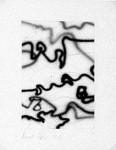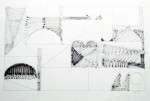1975
1975 Works
3D/Miscellaneous
Paintings
Works on Paper





Arkley’s career now began to gather significant momentum. His first solo show, held at Tolarno in April, impressed the critics; Maureen Gilchrist, for instance, in her review in the Melbourne Age, admired the way these ‘quiet, reductive paintings’ worked effectively as a series.
In June, Bernard Boles wrote a particularly incisive account of Arkley’s developing style in the Nation Review, describing his ‘Second Tracing’ – identified here as Oriental (Wave Study) 1974 – as the ‘clear winner’ of the Inez Hutchinson Prize (the identification is also supported by Alan McCulloch who, in the Melbourne Herald, described the work as ‘an arrangement of floating bamboo shapes,… gathered at the waist, so to speak’). For Boles, Arkley’s work was based on a lucid process of cleaning the mind of ideas; then, ‘he builds up from this void with a heightened awareness of every element he employs on the canvas’. These insightful comments, evidently based on detailed conversation with the artist, constitute the earliest sustained analysis of several key ideas motivating the work of his early maturity.
Significant insights into Arkley’s developing aesthetic are also provided by his Visual Diaries, the earliest of which, all in the form of school exercise books, date from 1975 (for details, see nos.1-4 in the sequence as listed in the linked entry). They brim with notes, sketches and ideas, including quotes from Paul Klee and other early heroes, and detailed notes on colour based on Johannes Itten (made while Arkley’s exhibited work was still strictly monochrome: for detailed discussion, see now Carnival 100ff., and also 111ff., for Arkley’s diaries).
Arkley also continued to produce numerous smaller works on paper during 1975, experimenting with the contrast between his air-brushed line and drawn or solid forms (see general remarks on early works on paper, under 1974).
1975 Exhibitions
‘Howard Arkley’, Tolarno Galleries, St Kilda, April-May 1975
– refer linked entry for full details
Minnie Crouch Prize exh., Ballarat Fine Arts Gallery, July-Sept.1975 [works on paper; check-list in Arkey’s archive; thanks to Anne Rowland, Ballarat Gallery Registrar, for information, Oct.-Nov.2008]
Inez Hutchinson Prize, Clive Parry Galleries, Beaumaris, c.June 1975 (winner: see reviews by Boles and McCulloch)
- Second Tracing: almost certainly = Oriental (Wave Study) 1974
Portland Acquisitive Prize 1975: Arkley is recorded as the winner in Duncan 1991: 32 and Spray 130; see also McCulloch 1984, vol.2, p.966, and McCulloch 2006, p.1179, s.v.’Prizes – Portland Art Society Art Prize’. Unfortunately, none of these sources indicate exactly what Arkley entered for this prize; however, his files do indicate that he submitted a painting called Seltsamer for the same prize in 1974 – identified here as Seltsamer (1974).
- (no details given)
























